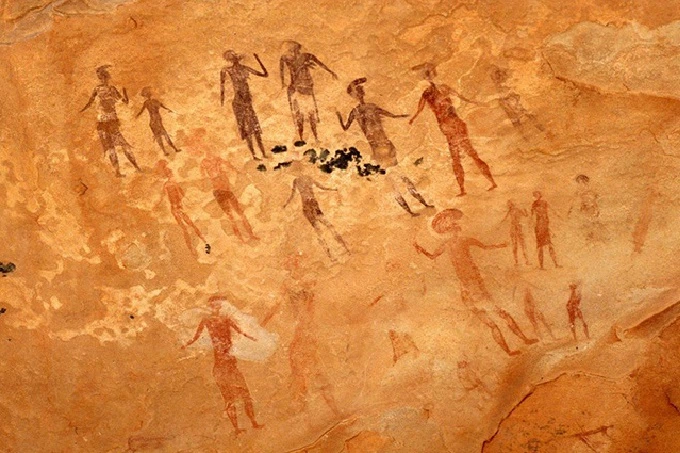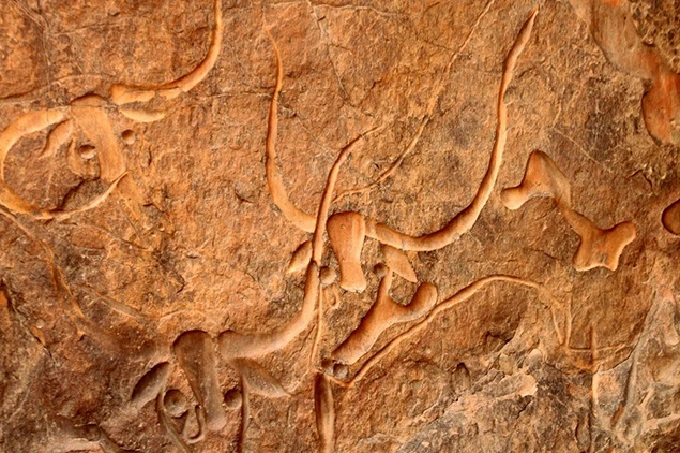Tassili n’ajjer: The mystery of prehistoric paintings in Algeria

In the southeast of Algeria, there is a large mountain plateau in the middle of the Sahara, Tassili n’ajjer, meaning the “plateau of chasms”, and this is the oldest monument of nature and art.
In Tassili n’ajjer, incredible landscapes and fantastic landscapes are more like the scenery for a space Hollywood blockbuster than a desert. Local caves keep the memory of those times when the Sahara was not yet endless sands. Scientists have discovered here the most ancient rock paintings existing on Earth.
These paintings are over 12 thousand years old! What secrets of the first people this stunningly beautiful and mysterious place hides?
Reserve and national park
The place, which covers an area of more than 70 thousand square kilometers, is an African national park and biosphere reserve. Since 1982, Tassili n’ajjer has been recognized as a UNESCO World Heritage Site.

The local sandstone is able to retain moisture, and the area has vegetation that contrasts strongly with the surrounding desert. Here you can find species of trees that are very rare and the most ancient in the world. These are Saharan cypresses and myrtles, which are threatened with extinction.
The entire surface of the sands is covered with rock formations formed as a result of erosion. The crown imposing dunes and resemble the ruins of ancient majestic cities from afar. These are huge rocky plains, which are sometimes replaced by a monolithic stone forest.
The relief is decorated with both free-standing sandstone remnant rocks and their groups in the form of walls, natural “arches,” and combinations of both. They hide in many caves. The plateau is covered by a whole network of riverbeds and dry gorges that have dried up for a long time. Numerous canyons and faults complete the picture of a fabulous landscape.
The Tuareg inhabits the entire plateau and mountain range. The nearest city from here is an oasis on the western edge of the region called Janet.
Rock paintings
In 1910, evidence of the existence of a prehistoric civilization was discovered in Tassili n’ajjer – the largest and oldest collection of rock art in the world. The local caves are decorated with a variety of pictorial creations of human hands – monochrome and color, relief and flat.
The first examples of this art date back to about 12,000 years ago, between 10 and 9 millennium BC. This is the period of the beginning of the Neolithic and the time towards the end of the last ice age. The Sahara was an inhabited savanna, not a desert at that distant time.
The plots of most ancient masterpieces indicate that the Sahara had a very humid climate in the Neolithic era, extremely rich and diverse flora and fauna. The frescoes of Tassili n’ajjer captured the entire evolution of the Sahara from the once flourishing savannah to the lifeless desert.

Once upon a time, various species of deciduous and coniferous trees, oaks, oleander and myrtle, citruses and olives grew here. Numerous valleys, now covered with sand, were at that time the same full-flowing rivers like the Nile and Niger.
So far, about 15,000 rock carvings have been identified. They feature large wild animals such as antelopes and crocodiles, herds of cattle, and people hunting and dancing. The most ancient of them correspond to animals that lived in the Sahara at the beginning of the Holocene. The people who created them were most likely hunter-gatherers and lived here more than 10 thousand years ago.
These paintings are among the oldest and largest in all of Africa, with some drawings reaching a height of 5 meters. Some paintings are characterized by the image of figures that seem to hover on the surface of the rock, with round heads and without distinctive features. It is believed that the places where they appeared were places dedicated to religious rituals and ceremonies.
With the domestication of cattle in the area about 4,500 years ago, sheep, cows, goats and dogs began to appear in the drawings. Next to them were depicted hunters with bows, women and children. A little later, horses and chariots with riders appeared on the frescoes. Writing began to be present in the form of ancient Libyan-Berber hieroglyphs, the meaning of which has not yet been deciphered.
All the paintings of Tassilin-Ajjer were created by many generations of people who, until now, inhabited these once fertile lands. They were mainly hunters, farmers and cattle breeders. Time passed, and the Sahara became a waterless desert. Over the millennia, relentless wind and heat have shaped the landscape as it exists today.
Unusual paintings
Approximately 3000 years ago, when the Sahara finally turned into a barren desert, figures of camels appeared in the drawings. They replaced donkeys and cattle previously depicted by people. In time, this coincides with the development of long-distance trade routes, along which caravans transported salt and other goods.

Among the most famous paintings is the so-called “Horned Goddess”. It was created in the Neolithic era and depicted a walking woman with horns on her head. Her arms and legs are decorated with bracelets, her clothes are fringed. The woman is possibly the goddess of fertility.
There are paintings in Tassili n’ajjer that even gave rise to the hypothesis among scientists that hallucinogenic substances were familiar to people in those days. Most likely mushrooms. The fact is that the frescoes depict several people in masks who are dancing. The dancers are surrounded by long and colorful garlands of geometric patterns of various kinds. Each of them holds in his right hand an object that looks like a mushroom, two parallel lines depart from it, which go straight to the crown of the dancer. Some researchers believe that this may reflect the influence of mushrooms on the human mind.
One of the main drawings confirming this theory is the figure of a shaman, whose entire body is covered with mushrooms. It is possible, of course, that this is connected with the funeral ritual. Most researchers believe that these ideas are not true. The world is full of amazing wonders and exciting secrets.




